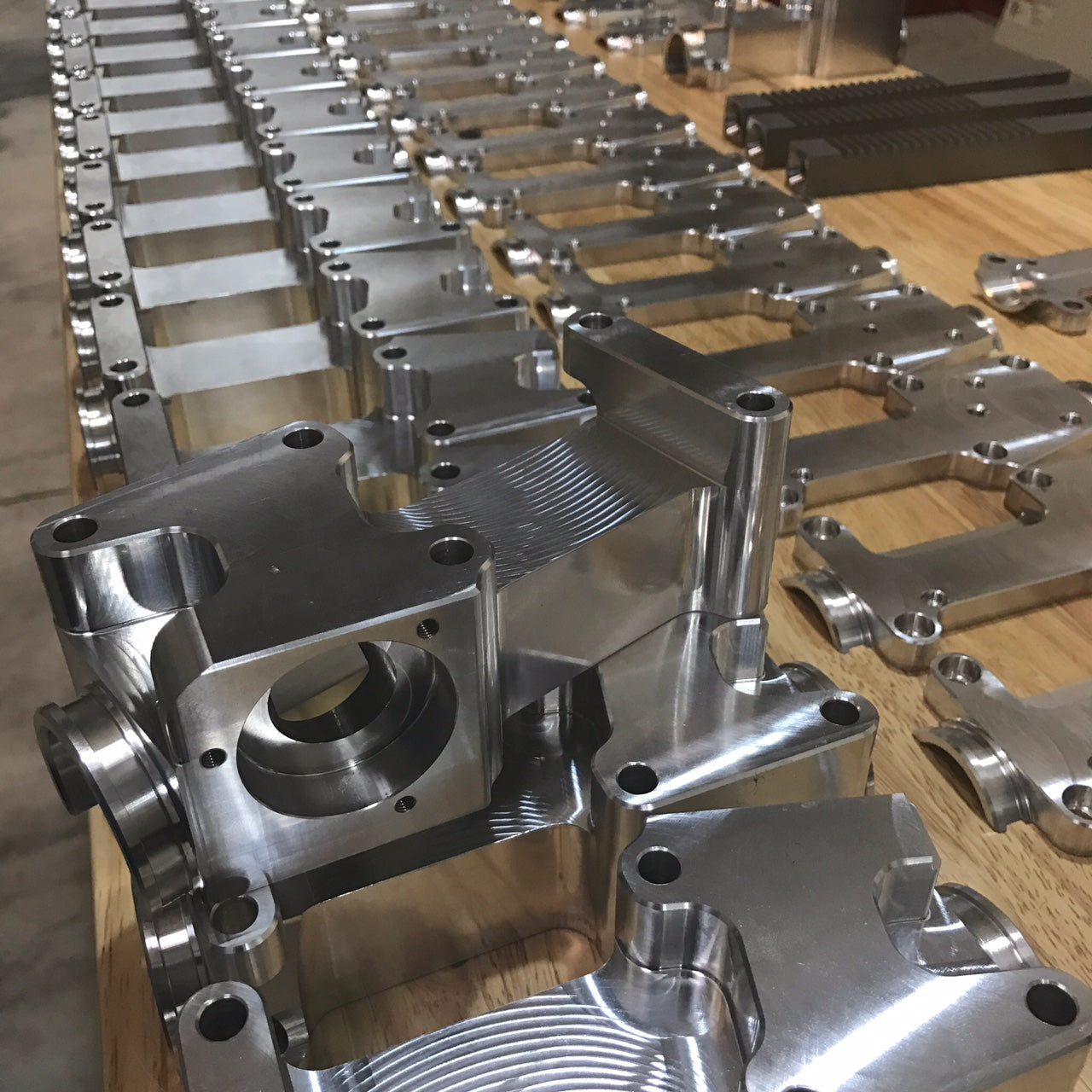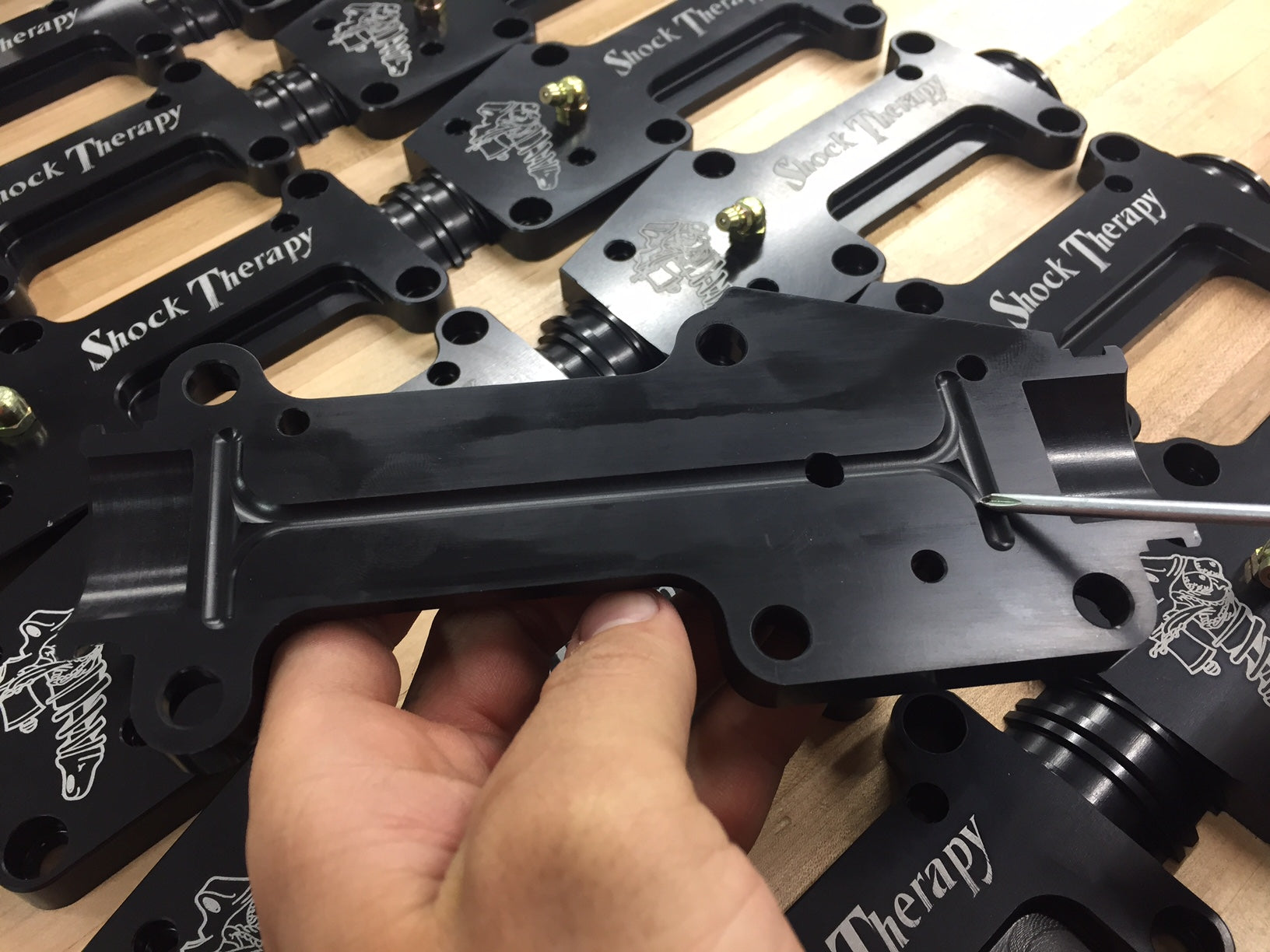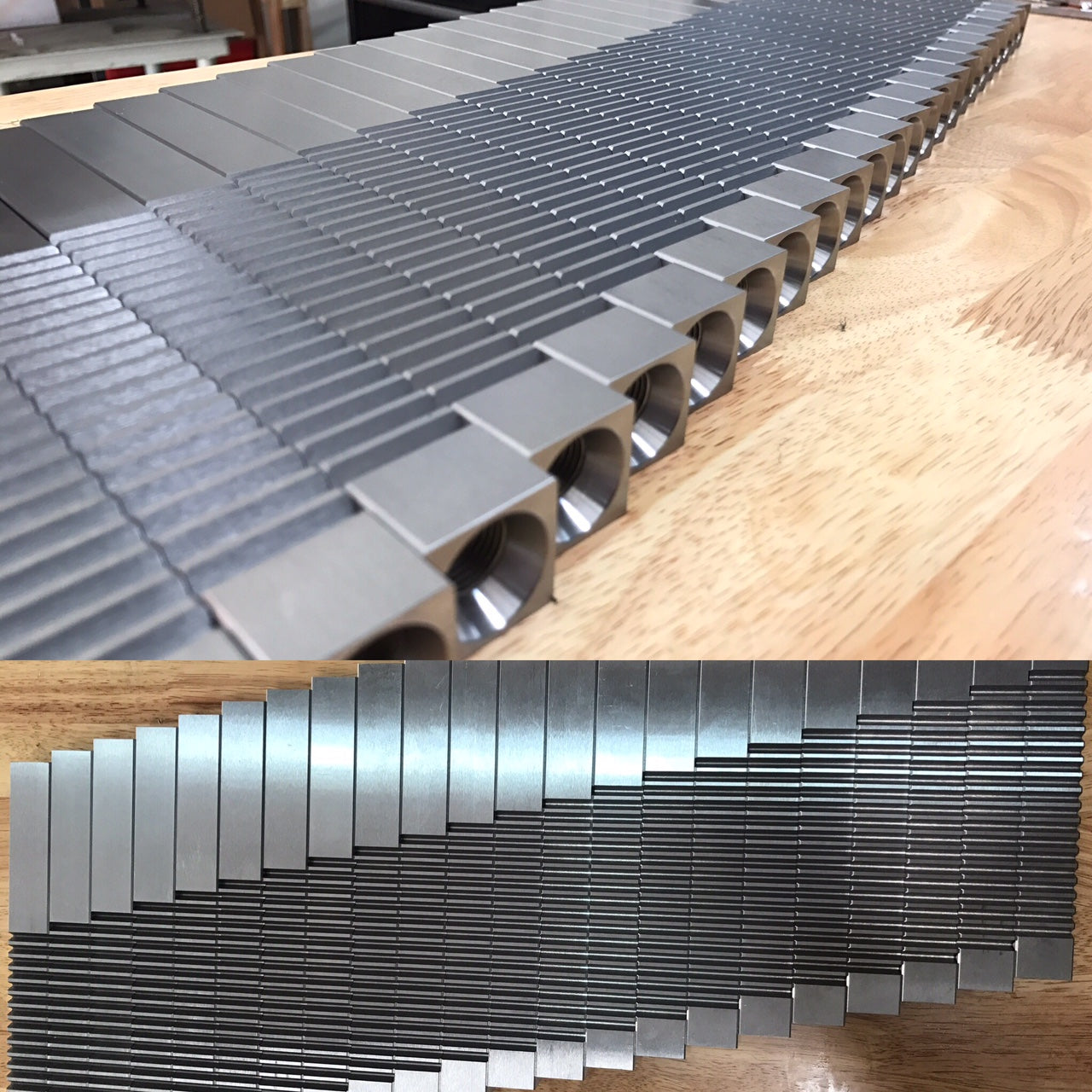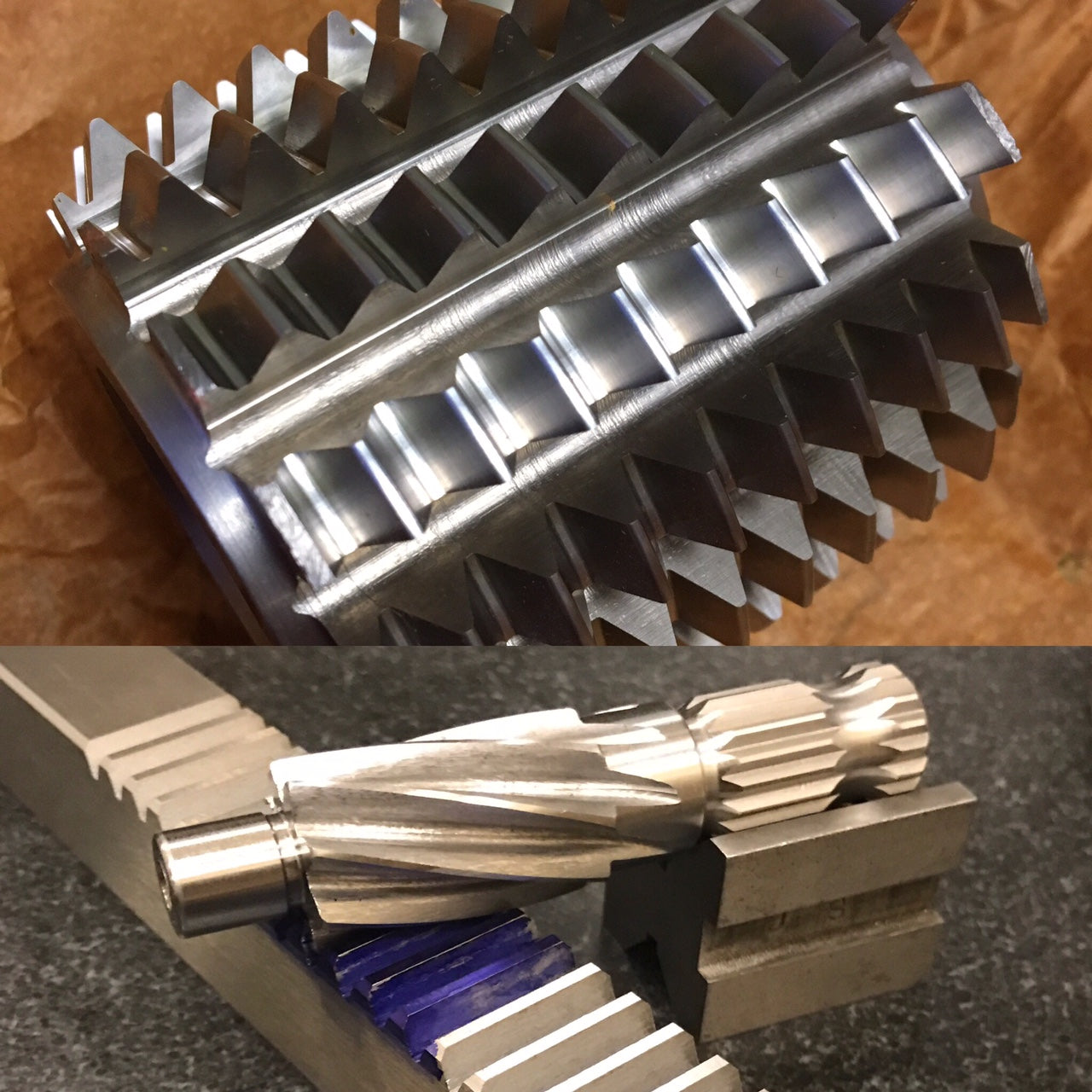Shock Therapy Polaris RZR RS1/General XP 1000 Steering Rack
After racing a "stock" rack and pinon in our shop XP Turbo with 32" tires we just didn't see any reason to change. We didn't have any excessive wear or rattle in it even after 1500 race miles on the rack. But then, while leading our next race, BOOM, lost all steering and we were done! After a post race inspection we found that the factory rack had sheered in half right in the center of the splined rack gear allowing one half to shoot out the right and one half to shoot out the left side of the rack body.
No problem, we thought, just order an aftermarket replacement from anyone and it must be better right? No so fast. The aftermarket replacements used rack gears that were barely .085 of an inch thicker at the same spot our rack had broken in two. Also, these racks spread the width of the tie rod pivots out as much as half of an inch. This is really bad. When you change the width of these pivot joints you add bump steer to your front end geometry. This means that as the suspension travels up and down the "Toe Setting" changes quite a bit toe in or toe out or both. This gives you nasty feed back in the steering wheel as you hit rocks or whoops which takes it's toll on your arms and hands, of course but the real damage is to your front end joints, bushings, ball joints and bearings. The life of these parts are seriously cut short if your car has bump steer. Another major negative with bump steer is the car tries to constantly "hunt" for a direction to go. As the tires change Toe so does the direction of your car. When ever you hit a bump, whoop or jump and you hold the wheel straight, the car will search for a direction by shooting left or right on it's own. This feeling is UN-nerving in a play car but down right dangerous in any race car. So our search continued for another rack and we found the only billet rack on the market. We bought it and loved the larger, square rack gear and custom tie rods but when we measured the width of the tie rod pivot points we found it was 1 1/2 inches too wide! This would create over 3 inches of bump steer? Wow, can't run that. With no other choices of racks to buy we were forced to make our own Race rack and here is a list of the things we put into our Race rack that you won't find in any other rack!
1. 7075 Aluminum Construction. This high grade of aluminum is almost as strong as carbon steel and costs 3 times as much as the more common 6000 series aluminum.

2. Hard Anodized Plating. This hardened surface not only prevents wear in the harshest of environments but it also extends the life of the rack internally.
3. Dispersed Grease Passage Lubrication. Our SINGLE grease fitting feeds 6 different spots in the rack through a network of internal passages. Proper lubrication is key to Rack life. Some of the spots the internal passages feed are the pinion gear, rack gear on all four sides and the vertical stress load spots where the rack gear sees the most potential wear. Tight internal tolerances make it so you will only need to grease our rack with two pumps of a grease gun every 1000 race miles during your routine prep.

4. Huge 1"x1" Square Rack Gear. This massive gear is twice as thick as the stock round gear at it's weak point in the tooth base. The size of this gear prevents bending and breakage but the material used is also 125% stronger than the stock material. Another important thing about a square rack gear is that it prevents twist. The stock, round gear tends to twist in the rack body as the tie rods force it up and down. This twist wedges the rack gear into the pinion tooth. This acts like a log splitter when it forces the sharp pinion tooth into the base of the rack gear tooth and creates the "snapped" rack gear problems the stock racks are known for. With our square rack gear there is no twisting force to worry about and thus removing all pinion gear forces from the rack gear.

5. Pre Heat Treated Rack Gear. Most racks use a soft material for the rack gear so they can machine the teeth into it easily. After the machine process the gear gets heat treated to increase it's strength. Heat treating warps the gear as much as 20 thousandths of and inch. In machine tolerance terms this is a massive amount so they try to bend it back or straighten it again but you can only straighten it so much and often there are waves in the gear from end to end. This means you have to increase the clearances in the body to allow the gear to move inside the rack. We didn't like this at all so we went a different route. We started with pre-hardened material that was perfectly straight and cut our gear teeth into that. This is a very expensive process since the tooling wears out very fast and the machine time is 5 times longer but the end result is a perfectly straight gear with less than 1 thousandth of an inch of run out from end to end! This tolerance allows us to tighten up the rack body and keep any play (which contributes to wear) in the rack to ZERO tolerance!
6. Patent Pending Gear Tooth Design. In choosing a tooth design we went with the industry standard that was readily available at first. Though exhaustive testing and purposely using weaker materials to find failure points, we found that the base of the standard tooth design was the weakest point and prone to breakage. We searched for another tooth design that was stronger but found nothing so we decided to make our own! Thousands of dollars in custom tooling later, we now have a patent pending tooth design that has TWICE the base thickness on the gear as a standard system does.

7. Heat Treated Pinion Gear. Our pinion gear starts out as a solid chunk of 4140 Chromoly material. After machining our custom tooth pattern we have the pinion heat treated to a 60 Rockwell. This is actually harder than a carbon steel drill bit for superior strength and longevity!
8. Pinion Bearings. The pinion bearing is often ignored but not here. Normally the pinion bearing is pressed into the rack housing. This puts pressure on the bearing inward and can tighten up the pinion and rack slide. We created a new system where the pinion bearing is not pressed in but just barely slides into the rack body with just 1 thousandth of an inch of clearance. Then, our bearing retainer plate has a 10 thousandth step in it which pre loads the bearing vertically into the housing so it can't move and can't tighten up on the pinion gear and slow down rack function. Lastly, there are many different bearings you can run in this spot from $5 all the way up to very high tolerance $30 bearings. We only run the $30 bearings of course.
9. Faster Steering Ratio. The factory rack has a two turn, lock to lock system. This means that if your driving straight and put your hand on top of the wheel in the center and turn as much as you can to the left, the wheel will rotate one full turn before it stops. One full turn back to straight and centered and one full turn to the right. This is two full turns from lock to lock. Our Race rack is a quicker system. It rotates the wheel just past 3/4 of a turn from center. This means that our rack has just over a 1.5 turn system. We tried to run a quicker ratio but found that the power in the electric power steering system was not enough for more ratio. The steering got heavy and cumbersome we we went back to a 1.5 turn system that is quicker but still felt great.
10. High Quality Rod Ends. Our Race rack uses huge 5/8 rod ends for the tie rod pivots on the ends of the rack gear. We would never run the lower quality injected rod ends. We only run the highest quality, Teflon lined, FK JMX10-T rod ends. You will be able to run a full Best in the Desert season on these rod ends with out having to replace them.
11. "Taper Lock" Jam Nuts. Our Patent Pending rod end jam nuts, called "Taper Lock" are an industry first. If you have done any racing with rod ends and jam nuts on your radius rods or tie rods or control arms you know that the jam nuts always loosen up. Most teams tack weld them in place to prevent this. We didn't want any one welding on our rack gear so we came up with the "Taper Lock" system that uses a machinist tool taper to lock the jam nut and rod end in place. As you tighten the jam nut, the male taper of the nut and the female taper of the rack gear seat together and lock just like a tool collet in a mill or lathe. These jam nuts double up as the steering stops for the rack travel as well. Positive lock and no loosening up are the only way to finish races!

12. 4130 Chromoly Clevises. Our tie rod clevises that allow you to attach your tie rods to our rack are huge. They are made from solid 4130 Chromoly and use high tolerance 5/8 diameter shoulder bolts to connect to the 5/8 rod ends in the rack. The WELD on clevises have two machined steps in them that are designed to insert into your tie rod tubing and weld on. The tubing diameters for the clevis are 1" .120 wall tubing and 1 1/4 .095 wall tubing. We also offer a 5/8 threaded clevis that are designed to thread into your aftermarket tie rods or into a long travel kit such as Assault, Cognito, Long Travel Industries and any other tie rod that uses a 5/8 rod end in their tie rod. Lastly, we also offer a longer clevis for Lone Star tie rods. Be sure to choose your clevis carefully so you get exactly what fits your tie rod system the best.
Weld on Clevis Below

5/8 Threaded Clevis Pictured Below

Lone Star Clevis Pictured Below. Uses a Longer 5/8" Thread to Fit the Lonestar Tie Rod

Payment & Security
Payment methods
Your payment information is processed securely. We do not store credit card details nor have access to your credit card information.





















